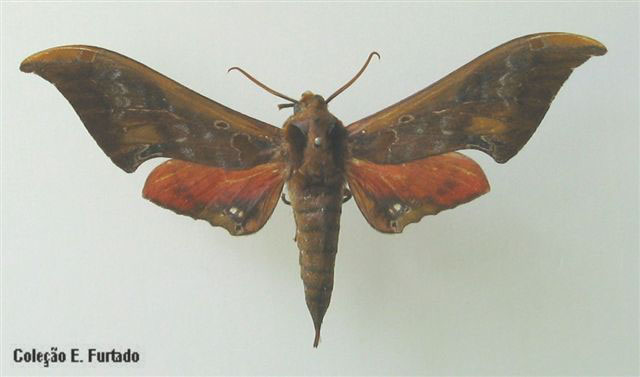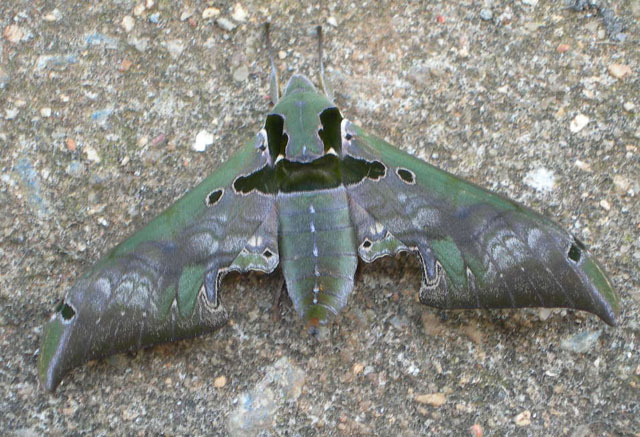Orecta lycidas lycidas
|
|
Updated as per "A Hawk Moths fauna of southern Maranhão state, Brazil, ... "; NEVA: Jahrgang 34 Heft 3 November 2013;
digital image source only, not indicative of range which in Brazil is only southeastern; via Jean Haxaire; April 5, 2014
|
Orecta lycidas lycidas
(Boisduval, [1875])
Ambulyx

Orecta lycidas lycidas male: 78 mm,
São Bento do Sul, Santa Catarina, Brazil,
September,
courtesy of Eurides Furtado.
This site has been created by
Bill Oehlke at oehlkew@islandtelecom.com
Comments, suggestions and/or additional information are welcomed by Bill.
| TAXONOMY:
Superfamily: Sphingoidea, Dyar, 1902
Family: Sphingidae, Latreille, 1802
Subfamily: Sphinginae, Latreille, 1802
Tribe: Smerinthini, Grote & Robinson, 1865
Genus: Orecta, Rothschild & Jordan, 1903
Species: lycidas lycidas, (Boisduval, [1875]) |
MIDI MUSIC
"What.A.Wonderful.World"
copyright C. Odenkirk
MIDI CITY
ON.OFF
<bgsound src="world.mid" LOOP=FOREVER>
|
DISTRIBUTION:
Orecta lycidas lycidas (wingspan: males: 76-82-87-93mm; females: ??) flies in
eastern Brazil: Minas Gerais, Santa Catarina, Parana.

Orecta lycidas lycidas male,
São Bento do Sul, Rio Vermelho, Santa Catarina, Brazil,
January, 2010, 800m,
courtesy of Jean Haxaire.

Orecta lycidas lycidas male (verso),
São Bento do Sul, Rio Vermelho, Santa Catarina, Brazil,
January, 2010, 800m,
courtesy of Jean Haxaire.
CATE lists Brazil, Bolivia, Paraguay, Eastern Argentina, but those locations may or may not also include subspecies Orecta lycidas eos.
BOLD systems includes only eastern Brazil and eastern Argentina.

Orecta lycidas, Itanhandu, Minas Gerais, Brazil,
January 13, 2010, courtesy of Larry Valentine.
The forewing apex is quite produced and bluntly pointed, but not truncated or excavate as in Protambulyx and Adhemarius species.
The forewing pattern is highly variable, ranging from a highly contrasting series of lines and patches to almost unmarked.
Slightly darker, dentate median and post median lines are followed by a suffusion of light greyish-white, diffuse scaling.
The dark colouration on the thorax is a good match for all of the following forewing characters: 1) small basal dot near body;, 2) broad, distal basal band not quite
reaching the costa; continuing with 3) a separate, slightly distal suboval patch bordering the lower edge of the costa; 4) a small preapical parallelogram on and
below the costa, broken by thin white line on lower edge of the costa; 5) a subtrapezoidal patch along the inner margin, atop the slightly excavate region
preceeding the anal angle. On the hindwing there is same coloured small dot near the anal angle. All of the dark regions, including the thoracic areas are outlined with
thin white lines.
The lighter colouration of the thorax (shoulders and center) is a good match for the following areas on the forewing: 1) most of the costa except for the darker,
preapical parallelogram; 2) upper sixth of median area; 3) an elongate costal apical patch distal to paralleogram; 4) a region atop the darker trapezoidal patch
along the inner margin; and on the hindwing the same colouration in a diffuse band along the slightly crenulate outer margin from the small dot near the anal angle,
running approximately half way to the apex.
The forewing cell spot is not prominent, being masked by a slightly darker region.
In subspecies Orecta lycidas eos, the median and post median lines are more prominent (darker), more broadly diffuse and are without the outer
suffusions of greyish-white scales. The dark markings are not accentuated with a thin, yet distinct greyish white outline as in the nominate subspecies.
The cell spot is much more distinct although diffuse.
The overall forewing ground colour is more consistent in eos, but in both species the forewing subterminal and terminal areas are dark.
FLIGHT TIMES AND PREFERRED FOOD PLANTS:
Orecta lycidas lycidas adults are on the wing in September, and probably at other times.
Orecta lycidas lycidas larvae feed upon
Laurus nobilis and Nectandra venulosa.
ECLOSION, SCENTING AND MATING:

Orecta lycidas lycidas female,
São Bento do Sul, Rio Vermelho, Santa Catarina, Brazil,
January, 2010, 800m,
courtesy of Jean Haxaire.

Orecta lycidas lycidas female (verso),
São Bento do Sul, Rio Vermelho, Santa Catarina, Brazil,
January, 2010, 800m,
courtesy of Jean Haxaire.
EGGS, LARVAE AND PUPAE:
Larval Food Plants
Listed below are primary food plant(s) and alternate food plants. It is hoped that this
alphabetical listing followed by the common name of the foodplant will
prove useful. The list is not exhaustive. Experimenting with closely
related foodplants is worthwhile.
Laurus nobilis
Nectandra venulosa......
|
Bay laurel
Nectandra venulosa
|
Return to Main Sphingidae Index
Return to Smerinthini Index





